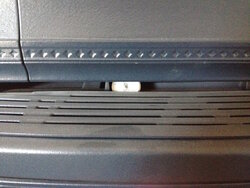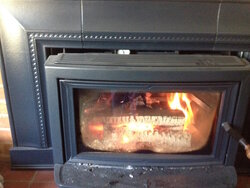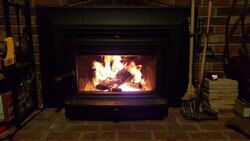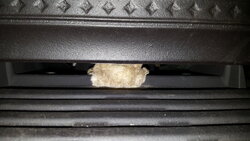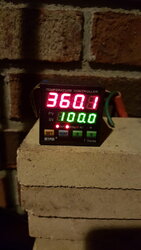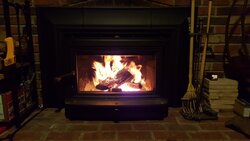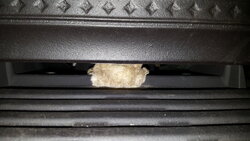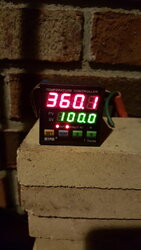Hello all, been reading almost every page on this site gaining a plethora of needed info for the new hearthstone clydesdale I installed a few weeks ago. It is in a 2200sf bilevel in the lower level, 6" smooth wall insulated liner 23', on a raised hearth with Roxul stuffed in all around the flue pipe as block off plate and all around behind the insert in the fireplace itself. I have 2-3 year seasoned wood, mix of oak, maple, walnut, birch, and ash. Mm reading on all 12-17% (fresh split then tested). The stove is an absolute beast of a heater easily heating the whole hse into the upper 70s in this milder weather 40s-50s, I have no doubt it'll work come the cold season especially with the 220cfm blowers. I am having problems getting a full load of wood to last for any length of time, contacted dealer (Gardens to Grow) and Ray at Hearthstone due to the fact that I am overdrafting in the high -.20s (using an electronic Testo combustion analysis tester and the old Bacharach manometer). I was told that either a restrictor plate or reducing cap could help solve the issue, has anyone used either with success, or has anyone modified the intakes on these or other stoves to compensate for the strong chimney pull? Thanks
Choke the chimney....
- Thread starter Clydeburner
- Start date
-
Active since 1995, Hearth.com is THE place on the internet for free information and advice about wood stoves, pellet stoves and other energy saving equipment.
We strive to provide opinions, articles, discussions and history related to Hearth Products and in a more general sense, energy issues.
We promote the EFFICIENT, RESPONSIBLE, CLEAN and SAFE use of all fuels, whether renewable or fossil.
You are using an out of date browser. It may not display this or other websites correctly.
You should upgrade or use an alternative browser.
You should upgrade or use an alternative browser.
- Status
- Not open for further replies.
Eaglecraft
Member
Hello all, been reading almost every page on this site gaining a plethora of needed info for the new hearthstone clydesdale I installed a few weeks ago. It is in a 2200sf bilevel in the lower level, 6" smooth wall insulated liner 23', on a raised hearth with Roxul stuffed in all around the flue pipe as block off plate and all around behind the insert in the fireplace itself. I have 2-3 year seasoned wood, mix of oak, maple, walnut, birch, and ash. Mm reading on all 12-17% (fresh split then tested). The stove is an absolute beast of a heater easily heating the whole hse into the upper 70s in this milder weather 40s-50s, I have no doubt it'll work come the cold season especially with the 220cfm blowers. I am having problems getting a full load of wood to last for any length of time, contacted dealer (Gardens to Grow) and Ray at Hearthstone due to the fact that I am overdrafting in the high -.20s (using an electronic Testo combustion analysis tester and the old Bacharach manometer). I was told that either a restrictor plate or reducing cap could help solve the issue, has anyone used either with success, or has anyone modified the intakes on these or other stoves to compensate for the strong chimney pull? Thanks
Clydeburner:
23 feet is not an unusually tall liner - mine is about 20 feet long terminating with a vacu-stack draft inducing rain cap. My home is a 2000 sq ft ranch, so heat distribution is a bit of a challenge, That said, Clyde does fine in keeping the house toasty warm. I have been heating with Clyde - I think this will be its fifth winter. Once I get a load burning fairly well, I stop down the air flow on Clyde to at least 3/4ths closed. I don't stop the air control all the way down, because one is always concerned about creosote build up. Like you, I only burn dry wood so I am less concerned about this problem. 12 to 17 percent moisture is very dry wood.
You didn't state in your original post how you operate the air control on Clyde. The position of the air controller has a significant effect on how long the splits will burn in Clyde. I would start adjusting the air control first, and keep a record of time to reload vs. air control position. Clyde does not have the biggest wood capacity of the inserts available, and I wish Clyde's were a bit bigger. But if Clyde were much bigger I wouldn't be able to get him in the fireplace opening.
It seems that Hearthstone would have some idea about your issue, but you have already spoken to them. There may be a building code issue here with respect to how much you could alter the size of the chimney. How about going to a larger diameter liner? Seems like that would reduce the draft of the set-up. Here again, there are code number concerning the cross-sectional area of the liner that you would have to respect.
Good luck in resolving your issue.
Thanks Eagle , I have had some more time to play with the controls and have gotten much longer burns, i usually set the air full open 10-20 min depending on load and then stagger the air down to almost the lowest setting. I can say for sure the 12% moisture wood is burning quick, but again with the mild temps still have plenty of coals for the morning. I mixed in a couple pieces of red oak at 17% moisture and it made a huge difference. I will have to wait and see if the draft will create more of a problem when the temps drop, but for now the Mrs is already complaining. ..ha haClydeburner:
23 feet is not an unusually tall liner - mine is about 20 feet long terminating with a vacu-stack draft inducing rain cap. My home is a 2000 sq ft ranch, so heat distribution is a bit of a challenge, That said, Clyde does fine in keeping the house toasty warm. I have been heating with Clyde - I think this will be its fifth winter. Once I get a load burning fairly well, I stop down the air flow on Clyde to at least 3/4ths closed. I don't stop the air control all the way down, because one is always concerned about creosote build up. Like you, I only burn dry wood so I am less concerned about this problem. 12 to 17 percent moisture is very dry wood.
You didn't state in your original post how you operate the air control on Clyde. The position of the air controller has a significant effect on how long the splits will burn in Clyde. I would start adjusting the air control first, and keep a record of time to reload vs. air control position. Clyde does not have the biggest wood capacity of the inserts available, and I wish Clyde's were a bit bigger. But if Clyde were much bigger I wouldn't be able to get him in the fireplace opening.
It seems that Hearthstone would have some idea about your issue, but you have already spoken to them. There may be a building code issue here with respect to how much you could alter the size of the chimney. How about going to a larger diameter liner? Seems like that would reduce the draft of the set-up. Here again, there are code number concerning the cross-sectional area of the liner that you would have to respect.
Good luck in resolving your issue.
I have yet to find where to take a good temperature reading on stove top being they can vary vastly from center front to back and across side to side about 100°. Can you tell me where you are reading your temps and at what temps you run at? I have been averaging 450-550 again depending where they are taken.
Eaglecraft
Member
Thanks Eagle , I have had some more time to play with the controls and have gotten much longer burns, i usually set the air full open 10-20 min depending on load and then stagger the air down to almost the lowest setting. I can say for sure the 12% moisture wood is burning quick, but again with the mild temps still have plenty of coals for the morning. I mixed in a couple pieces of red oak at 17% moisture and it made a huge difference. I will have to wait and see if the draft will create more of a problem when the temps drop, but for now the Mrs is already complaining. ..ha ha
I have yet to find where to take a good temperature reading on stove top being they can vary vastly from center front to back and across side to side about 100°. Can you tell me where you are reading your temps and at what temps you run at? I have been averaging 450-550 again depending where they are taken.
Clydeburner:
From the two photos you can see where I located Clyde's stove thermometer. It's an Omega thermometer. It has a maximum reading of 700 degrees F. I placed it where I thought was a logical area - because I could read it. It is leaning more or less against the flue collar.
This measurement, and I think that any stove temperature measurement, is purely relative. It is an indicator, not an absolute measurement. I placed the thermometer there just to keep from over-firing the stove. I try to keep temps (as indicated by the thermometer) less than 500 degrees. Could I operate the stove at a higher temp without damaging the stove? I believe that I could.
I have no engineering data that tells me what the maximum stove temp for Clyde should be, or where temperatures should be measured. I don't recall what Clyde's manual says about operating temperatures. It probably says something like (and I have not looked at the manual for years) "Don't over-fire the stove."
Obviously one can't go nuts with these stoves so a conservative approach is appropriate. Was it Ben Franklin who said, "Moderation in all things." I can't remember who said it.
I wish that I had some hard wood to burn. We have some fruit trees in our general area, but mostly we burn soft woods - pine, spruce, aspen (a soft hardwood)etc. I find that our fruit trees - apple, cherry, etc don't give very big splits and they have a lot of knots. But I try to "age" my pine and spruce at least three years and I burn them fairly hot.
Attachments
Clydeburner:
From the two photos you can see where I located Clyde's stove thermometer. It's an Omega thermometer. It has a maximum reading of 700 degrees F. I placed it where I thought was a logical area - because I could read it. It is leaning more or less against the flue collar.
This measurement, and I think that any stove temperature measurement, is purely relative. It is an indicator, not an absolute measurement. I placed the thermometer there just to keep from over-firing the stove. I try to keep temps (as indicated by the thermometer) less than 500 degrees. Could I operate the stove at a higher temp without damaging the stove? I believe that I could.
I have no engineering data that tells me what the maximum stove temp for Clyde should be, or where temperatures should be measured. I don't recall what Clyde's manual says about operating temperatures. It probably says something like (and I have not looked at the manual for years) "Don't over-fire the stove."
Obviously one can't go nuts with these stoves so a conservative approach is appropriate. Was it Ben Franklin who said, "Moderation in all things." I can't remember who said it.
I wish that I had some hard wood to burn. We have some fruit trees in our general area, but mostly we burn soft woods - pine, spruce, aspen (a soft hardwood)etc. I find that our fruit trees - apple, cherry, etc don't give very big splits and they have a lot of knots. But I try to "age" my pine and spruce at least three years and I burn them fairly hot.
Clydeburner:
From the two photos you can see where I located Clyde's stove thermometer. It's an Omega thermometer. It has a maximum reading of 700 degrees F. I placed it where I thought was a logical area - because I could read it. It is leaning more or less against the flue collar.
This measurement, and I think that any stove temperature measurement, is purely relative. It is an indicator, not an absolute measurement. I placed the thermometer there just to keep from over-firing the stove. I try to keep temps (as indicated by the thermometer) less than 500 degrees. Could I operate the stove at a higher temp without damaging the stove? I believe that I could.
I have no engineering data that tells me what the maximum stove temp for Clyde should be, or where temperatures should be measured. I don't recall what Clyde's manual says about operating temperatures. It probably says something like (and I have not looked at the manual for years) "Don't over-fire the stove."
Obviously one can't go nuts with these stoves so a conservative approach is appropriate. Was it Ben Franklin who said, "Moderation in all things." I can't remember who said it.
I wish that I had some hard wood to burn. We have some fruit trees in our general area, but mostly we burn soft woods - pine, spruce, aspen (a soft hardwood)etc. I find that our fruit trees - apple, cherry, etc don't give very big splits and they have a lot of knots. But I try to "age" my pine and spruce at least three years and I burn them fairly hot.
Thanks again Eaglecraft I too have my sensor in the same location I find it to be reading about 30°f hotter then in the center of the stove top, which by the way is where the manual says to take the temps from... ha ha and it also states not to routinely exceed 600°f.I seem to peak out around 575°so I'd think I should be in the safe zone.
I found a PID controller with a type k 750° sensing probe on Ebay for $25, had it hooked up in 10 mins. Trying to find the right spot to put it was a little tougher, especially when it's up and running...
Still been waiting for the weather to turn here to actually get a chance to see how she's gonna run, this weekends forecast is still only 30°f at night then back to 50°f next week. I suppose it's not too bad being I haven't gotten all my wood put away yet, if I could only get a day off of work... yea right! ha ha
I tend to burn my apple, cherry, pear, ext. in the smoker for the weekend bbq'n... mmmmmmmmmm I do love the smoke.
Attachments
Didn't realize it dbld the pics...Thanks again Eaglecraft I too have my sensor in the same location I find it to be reading about 30°f hotter then in the center of the stove top, which by the way is where the manual says to take the temps from... ha ha and it also states not to routinely exceed 600°f.I seem to peak out around 575°so I'd think I should be in the safe zone.
I found a PID controller with a type k 750° sensing probe on Ebay for $25, had it hooked up in 10 mins. Trying to find the right spot to put it was a little tougher, especially when it's up and running...
Still been waiting for the weather to turn here to actually get a chance to see how she's gonna run, this weekends forecast is still only 30°f at night then back to 50°f next week. I suppose it's not too bad being I haven't gotten all my wood put away yet, if I could only get a day off of work... yea right! ha ha
I tend to burn my apple, cherry, pear, ext. in the smoker for the weekend bbq'n... mmmmmmmmmm I do love the smoke.
And there is insulation on top of the sensing probe to prevent the blower from affecting the reading
Smoked
Feeling the Heat
If Ray is recommending something to reduce draft I think you should continue to research that. You can control the burn with larger splits and having the primary a low as possible but think the draft will have you burning through more wood than you want. I expect in the colder weather, you will be able to turn primary almost all the way off and still have a nice secondary burn.
I am waiting for a steadier colder temp to verify the draft which Ray said he wanted to see how things might change then too. I am not enthusiastic about having to choke the top of the chimney causing the bottling effect and more smoke spillage in the house on reloads, but if it's the only option then have to learn that curve when it comes.I was looking to see if anyone else had had similar drafting and had tried choking their chimney and what the effects where positive and negatives
I have had little to no flame and the secondaries rolling around nicely and have been able to get 6 or so hours of burn leaving plenty of coals and a fast reload. I just don't want to be wasting wood like you had mentioned, though this stove is a huge improvement over my old Glacier Bay which was always hungry for another split ha ha. I guess time will tell.
I have had little to no flame and the secondaries rolling around nicely and have been able to get 6 or so hours of burn leaving plenty of coals and a fast reload. I just don't want to be wasting wood like you had mentioned, though this stove is a huge improvement over my old Glacier Bay which was always hungry for another split ha ha. I guess time will tell.
gls289
Member
I have an Auber Instruments connected to the draft bolt on my Clyde. Spent some time with an IR gun comparing readings so I know what my actual temps are. I really like using the draft bolt location as it's an instant read versus having to wait on the soapstone and cast iron to heat up. The draft bolt location also allows me to hide everything which was apparently very important to me, I just didn't realize it until my wife told me.
Ha ha gls289 that is true I've had my wife compliment things I've done to only then see what she had seen. So do you have the bolt on style thermocouple on the draft bolt or did you remove it and actually insert a probe? I found the temps with a probe Inserted in place of the draft bolt seemed way higher then stove top, more like actual flue temp readings. Which I suppose you could just subtract the difference.I have an Auber Instruments connected to the draft bolt on my Clyde. Spent some time with an IR gun comparing readings so I know what my actual temps are. I really like using the draft bolt location as it's an instant read versus having to wait on the soapstone and cast iron to heat up. The draft bolt location also allows me to hide everything which was apparently very important to me, I just didn't realize it until my wife told me.
9400109699937089287367
So more with the chimney....
I had tried making flue restrictor plates by cutting 5" and 4" holes in some metal I had laying around installing them at the top of the chimney with no change in the operation (-.23 + draft). I contacted Hearthstone again was told a draft key damper could be the ultimate cure with no ill effects on the stove, only the benefits of putting the heat in the house and not up the chimney. I since then have installed one at the top of the stove with a little engineering I'm on my way to having the control arm out through the surround. The wife isn't too thrilled about having to drill the surround, but if it helps the operation as a whole. It has made a huge difference in the overall burn and control, I have to make the final install as this is only for testing purposes and not correct chimney piping. Working nights this week so we'll see how things go.... to be continued
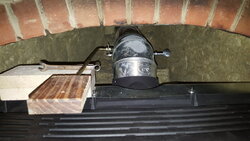
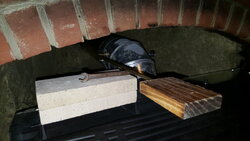
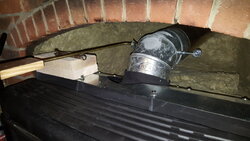
So more with the chimney....
I had tried making flue restrictor plates by cutting 5" and 4" holes in some metal I had laying around installing them at the top of the chimney with no change in the operation (-.23 + draft). I contacted Hearthstone again was told a draft key damper could be the ultimate cure with no ill effects on the stove, only the benefits of putting the heat in the house and not up the chimney. I since then have installed one at the top of the stove with a little engineering I'm on my way to having the control arm out through the surround. The wife isn't too thrilled about having to drill the surround, but if it helps the operation as a whole. It has made a huge difference in the overall burn and control, I have to make the final install as this is only for testing purposes and not correct chimney piping. Working nights this week so we'll see how things go.... to be continued



Last edited by a moderator:
You are lucky there's room to put in a key damper. Will the elbow be switched out to a stainless steel elbow?
Begreen,You are lucky there's room to put in a key damper. Will the elbow be switched out to a stainless steel elbow?
yes I have a stainless elbow, that galvanized one was more for fit and testing. The stove has died down and I will be taking it apart and installing the stainless material for the final fit. I was expecting with my set up that I would be fighting poor draft as I did with my old stove , being I have the 15" back to the smooth wall insulated 6" liner, but I am not...
Well with a little free time this morning I tore onto the draft damper install. I threaded the damper rod, installed it in the stainless steel elbow sealing all the joints with high temp cement, fabricated an offset bracket, and bent up an old fire poker rod/handle. Made some measurements and drilled the hole through the surround. I quick made up a wooden handle and torched it for the more rustic look (I'm sure my wife will want something else) but for not it works. I don't feel I'll need it every fire but when it's 10°f out and the chimney is pulling like a John Deere at the sled track I know I can turn her down and enjoy the show....
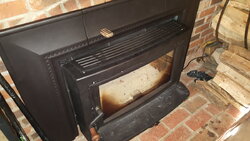
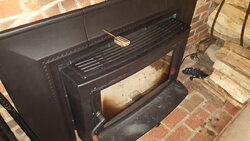


Last edited by a moderator:
Heftiger
Feeling the Heat
Thank you Heftiger, wasn't sure at first especially with having to drill through the surround, but all went well. Now to see if it passes the bosses inspection ha ha 



- Status
- Not open for further replies.
Similar threads
- Replies
- 8
- Views
- 5K


